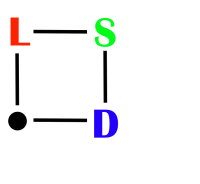The SF approach
In a typical lattice simulation, we must keep our observables well separated from both the lattice spacing a and the box size L. This is hard enough, but here we want to see the evolution of the running coupling over a huge change in scale!
We use the Schrodinger Functional (SF) scheme, which “turns a bug into a feature” - the coupling constant is defined directly at the box scale L, so it has no finite-size corrections.
In the SF approach, Dirichlet boundaries are imposed in the time direction, with boundary gauge field values set so that the classical solution within the lattice is a constant chromoelectric field.
The coupling constant g is then defined by the inverse response of the action of the system as the strength of the background chromoelectric field is varied.
From 8/12 flavors to 10 flavors
Unfortunately, transitioning from the study of 8 and 12 flavors to the 10-flavor problem is not as simple as dialing in the number of flavors.
The values of 8 and 12 were chosen for the initial study so that we could employ staggered fermions, which are cheap to simulate but naturally come in multiples of four degenerate flavors.
Of course, staggered fermions can be used to simulate 2 flavors or 1 flavor, by way of the rooting trick - taking fractional powers of the fermion determinant to reduce Nf. But as noted above, we would like to simulate directly at zero quark mass here, and there is some evidence that doing so when rooting can lead to an incorrect continuum limit (see e.g. S. Sharpe, hep-lat/0610094.)
To avoid the issue of rooting, we have to switch from staggered to Wilson fermions. Wilson fermions are substantially more expensive to simulate, but we can offset this by using an efficient code base, and using both perturbative and non-perturbative improvement (clover action) to cancel lattice artifacts.
Switching to Chroma
The Chroma code base is very actively maintained and heavily optimized, with a particular focus on Wilson fermions. Switching from MILC to Chroma is thus a natural choice as we move to 10 flavors.
Although there is some Schroedinger functional code already present within Chroma, it is primarily geared towards measurement of currents used in non-perturbative tuning of the clover coefficient. Significant new pieces of code to be added in this project include a new action with perturbative boundary improvement terms, and the running coupling measurement itself.
Non-perturbative tuning
Besides computational cost, another drawback of Wilson fermions is that the quark mass is subject to additive renormalization. Rather than simply setting the bare mass to zero and simulating away, we must perform a series of tuning simulations to get the renormalized mass to vanish.
Since non-perturbative tuning will already be required, we also choose to include the clover term in our action. This term requires a further tuning step, but its presence removes bulk lattice artifacts at order a/L. In our experience at 8 and 12 flavors, continuum extrapolation has been a major source of systematic error, so any reduction of a/L effects is likely to be helpful
Technical details of the non-perturbative tuning, along with other details about this simulation, can be found in our whitepaper.
